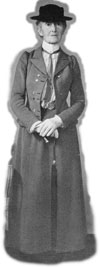To fit into Aboriginal society
Daisy Bates tried a number of guises to win the trust of her Aboriginal hosts, including magic.
To be Kabbarli |
At Ooldea, not wishing to interfere in their associations with the white people, who were always kind to them, I could do no more than think for them with my ‘black-fellow’s mind’, dispensing my Kabbarli wisdom for what it was worth from the knowledge gained through half a lifetime, and my Kabbarli comfort to the very limit of my means and my physical endurance. |
| Daisy Bates (1859 - 1951) The Passing Of The Aborigines: A Lifetime Spent Among The Natives Of Australia London: Murray, 1938, p. 207 | |
To be Kallower |
She noted that ‘the natives live in an atmosphere of superstition, with unseen forces always at work among them.’ She decided to exploit this fact, and it was then that she invented the native term of Kallower. She let it be known that she was a mirrunroojandu, a magic woman who had been one of the twenty-two wives of Leberr, a ‘dreamtime’ father. |
| Elizabeth Salter Daisy Bates: The Great White Queen Of The Never Never Sydney: Angus & Robertson, 1971, p. 97 | |
|
I pretended that my native name was Kallower, and that I was a mirruroo-jandu, or magic woman who had been one of the twenty-two wives of Leeberr, a patriarchal or ‘dreamtime’ father. After that, the way was clear. |
|
| Daisy Bates (1859 - 1951) The Passing Of The Aborigines: A Lifetime Spent Among The Natives Of Australia London: Murray, 1938, p. 24 | |
To be jangg'a |
As a jangg’a, or white skin, she was believed to have come from their dreamtime and so was expected to know and to respect their laws… Among the Bibbulums she was a tondarrup, which the classfication of ‘father’s sister’, which might be roughly interpreted as a kind of tribal aunt. She would have known at which fire she might sit, and the people by whom she would be joined. |
| Elizabeth Salter Daisy Bates: The Great White Queen Of The Never Never Sydney: Angus & Robertson, 1971, p. 94 | |
To smell whiteness |
Everywhere I heard the plaint—’Jangga meenya bomunggur’ (The smell of the white man is killing us). |
| Daisy Bates (1859 - 1951) The Passing Of The Aborigines: A Lifetime Spent Among The Natives Of Australia London: Murray, 1938, p. 80 | |
To keep secrets |
As I turned one long board face upwards, Yalli-yalla reverently touched it, then placed his hand upon my breast and then on his own. It was the curlew totem of his fathers that he had never seen since his own young manhood. He knew that the spirit of all totems was within my breast. |
| Daisy Bates (1859 - 1951) The Passing Of The Aborigines: A Lifetime Spent Among The Natives Of Australia London: Murray, 1938, p. 241 |
